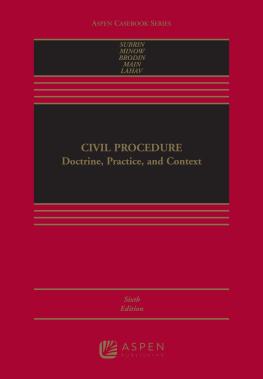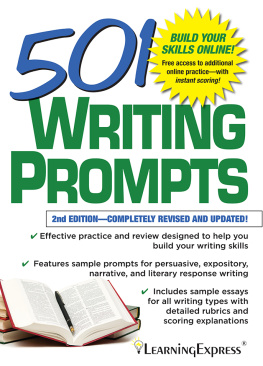WEST ACADEMIC PUBLISHINGS
LAW SCHOOL ADVISORY BOARD
JESSE H. CHOPER
Professor of Law and Dean Emeritus,
University of California, Berkeley
JOSHUA DRESSLER
Professor of Law, Michael E. Moritz College of Law,
The Ohio State University
YALE KAMISAR
Professor of Law Emeritus, University of San Diego
Professor of Law Emeritus, University of Michigan
MARY KAY KANE
Professor of Law, Chancellor and Dean Emeritus,
University of California,
Hastings College of the Law
LARRY D. KRAMER
President, William and Flora Hewlett Foundation
JONATHAN R. MACEY
Professor of Law, Yale Law School
ARTHUR R. MILLER
University Professor, New York University
Formerly Bruce Bromley Professor of Law, Harvard University
GRANT S. NELSON
Professor of Law, Pepperdine University
Professor of Law Emeritus, University of California, Los Angeles
A. BENJAMIN SPENCER
Professor of Law, University of Virginia School of Law
JAMES J. WHITE
Professor of Law, University of Michigan
i
Acing
Civil Procedure
Fourth Edition
A Checklist Approach to Solving Procedural Problems
by
A. Benjamin Spencer
Professor of Law
University of Virginia School of Law
Series Editor
A. Benjamin Spencer
ACING SERIES

Mat #41625740
ii
The publisher is not engaged in rendering legal or other professional advice, and this publication is not a substitute for the advice of an attorney. If you require legal or other expert advice, you should seek the services of a competent attorney or other professional.
Acing Series is a trademark registered in the U.S. Patent and Trademark Office.
West, a Thomson business, 2005, 2008
2011 Thomson Reuters
2014 LEG, Inc. d/b/a West Academic
444 Cedar Street, Suite 700
St. Paul, MN 55101
1-877-888-1330
West, West Academic Publishing, and West Academic are trademarks of West Publishing Corporation, used under license.
Printed in the United States of America
ISBN: 978-1-62810-041-9
iii
For Marlette, Isabella, Mya, James, Mary Alice, Emma, Alyssa and Adam
v
Preface
This book was written to help the large number of students who emerge every year from their civil procedure courses dazed and confused. Civil procedure for many is the most confounding of subjects, dealing with technical arcana that beginning law students have a difficult time getting their minds around. Civil procedure does not have to be so difficult and indeed can be quite interesting to study. After teaching my own students the topic, I learned early on that they would benefit greatly from a useful organizing tool that brought all of the material for each subject together, not only in a way that would facilitate understanding, but also in a way that could be used to solve the problems they would face in working through classroom hypotheticals or examination questions. So I began developing checklists for their benefit that I presented to my students at the end of each unit. I found the students not only to be extremely grateful for this information, but it was universally reported to me that these checklists greatly enhanced their understanding of the material and gave them a method for attacking procedural problems that they otherwise might have had difficulty developing on their own.
It is with the goal of sharing this useful tool with students beyond those in my own classes that I offer this book. I hope that readers find these checklists to be as useful as my students have found them to be.
A. BENJAMIN SPENCER
April 2014
vii
About the Author
A. BENJAMIN SPENCER is a Professor of Law at the University of Virginia School of Law. He is a graduate of Morehouse College, The London School of Economics (Marshall Scholar), and Harvard Law School, where he was an Articles Editor of the Harvard Law Review. After law school, Professor Spencer served a one-year clerkship with Judge Judith W. Rogers of the U.S. Court of Appeals for the D.C. Circuit. Before becoming a law professor, Professor Spencer worked as a Litigation Associate in a New York-based law firm for two years. A member of the American Law Institute and the West Publishing Company Law School Advisory Board, Professor Spencer teaches and publishes in the area of civil procedure.
xiii
Acing
Civil Procedure
Fourth Edition
Introduction
W hen I was in law school, most students spent a good deal of time developing an outline for each coursea lengthy (Ive seen outlines well over 100 pages in length) and exhaustive document that purports to compile the universe of information presented in a course into an organized, accessible format that would simplify studying and provide a useful source for information during the exam (provided the exam was open-book).
I too engaged in this time-honored practice, using a collection of previously developed outlines and my own class notes to form my own version of an outline for each course. Beyond its usefulness as a reference tool during my exams, I found the process of drafting outlines useful in forcing me to review my notes and other materials in a more meaningful way than simply re-reading those materials would have demanded.
Unfortunately, my outlines never were able to provide me with anything more than a restatement of various principles of law or doctrine organized by topic; it remained for me to take those doctrines and apply them to the fact patterns presented in my exams. That process of applying legal principles to facts is a large part of what law school, law school exams, and lawyering are all about; knowing the relevant law is only half (oftentimes less than half) of the battle. So why were I and my fellow students devoting all of this time and energy into developing these miniature tomes on the law of Contracts, Torts, Civil Procedure, etc., and not putting more energy into developing a tool that could help guide our legal analysis of problems presented on exams?
In addition to an outline, there was another document that some students including myself occasionally developed as an examination aid: the checklist. There was not a single definition for a checklist or a consistent approach to drafting one. But at bottom, a checklist was meant to present in a sparse and simplified way the basics about a topic that one wanted to be sure to remember to discuss or evaluate in the course of ones examination answer. Some checklists were simply bullet points of elements or rules under larger topical headings. Others were more involved in linking various concepts together in a logical pattern that facilitated the analysis of legal problems. Regardless of the format, I never developed or came across a checklist for any of my courses that made much of a contribution beyond being a condensed form of the lengthier outline prepared for the course.
Since I started teaching as a law professor, I have given the checklist a second look. Properly conceived and crafted, I have come to believe that checklists can fulfill the role of providing a tool that truly aids students in their effort to analyze legal problems in their courses. I define a useful checklist as follows: A document that presents the series of questions that must be asked and answered, in sequence, in order to resolve a legal issue that is presented.
There is a general structure to legal analysis that involves identifying the issue, articulating the applicable legal rules and principles, applying those principles to a given set of facts, and then arriving at and stating a conclusion. While this structure provides a sound overarching approach to tackling legal problems in law school, the process of identifying the relevant legal principle and then applying it to the situation is typically more involved than this general model suggests. The process of arriving at the right rule and application of that rule is somewhat akin to the thought process illustrated by decision trees, where the way in which an initial question is answered determines which of several alternative paths one follows in order to get to the next appropriate question.





